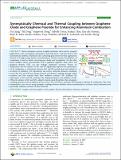| dc.contributor.author | Jiang, Yue | |
| dc.contributor.author | Deng, Sili | |
| dc.contributor.author | Hong, Sungwook | |
| dc.contributor.author | Tiwari, Subodh | |
| dc.contributor.author | Chen, Haihan | |
| dc.contributor.author | Nomura, Ken-ichi | |
| dc.contributor.author | Kalia, Rajiv K. | |
| dc.contributor.author | Nakano, Aiichiro | |
| dc.contributor.author | Vashishta, Priya | |
| dc.contributor.author | Zachariah, Michael R. | |
| dc.contributor.author | Zheng, Xiaolin | |
| dc.date.accessioned | 2020-10-14T18:58:31Z | |
| dc.date.available | 2020-10-14T18:58:31Z | |
| dc.date.issued | 2020-01 | |
| dc.date.submitted | 2019-11 | |
| dc.identifier.issn | 1944-8244 | |
| dc.identifier.issn | 1944-8252 | |
| dc.identifier.uri | https://hdl.handle.net/1721.1/127994 | |
| dc.description.abstract | Metal combustion reaction is highly exothermic and is used in energetic applications, such as propulsion, pyrotechnics, powering micro-and nano-devices, and nanomaterials synthesis. Aluminum (Al) is attracting great interest in those applications because of its high energy density, earth abundance, and low toxicity. Nevertheless, Al combustion is hard to initiate and progresses slowly and incompletely. On the other hand, ultrathin carbon nanomaterials, such as graphene, graphene oxide (GO), and graphene fluoride (GF), can also undergo exothermic reactions. Herein, we demonstrate that the mixture of GO and GF significantly improves the performance of Al combustion as interactions between GO and GF provide heat and radicals to accelerate Al oxidation. Our experiments and reactive molecular dynamics simulation reveal that GO and GF have strong chemical and thermal couplings through radical reactions and heat released from their oxidation reactions. GO facilitates the dissociation of GF, and GF accelerates the disproportionation and oxidation of GO. When the mixture of GO and GF is added to micron-sized Al particles, their synergistic couplings generate reactive oxidative species, such as CFx and CFxOy, and heat, which greatly accelerates Al combustion. This work demonstrates a new area of using synergistic couplings between ultrathin carbon nanomaterials to accelerate metal combustion and potentially oxidation reactions of other materials. | en_US |
| dc.language.iso | en | |
| dc.publisher | American Chemical Society (ACS) | en_US |
| dc.relation.isversionof | http://dx.doi.org/10.1021/acsami.9b20397 | en_US |
| dc.rights | Creative Commons Attribution-Noncommercial-Share Alike | en_US |
| dc.rights.uri | http://creativecommons.org/licenses/by-nc-sa/4.0/ | en_US |
| dc.source | Prof. Slocum via Elizabeth Soergel | en_US |
| dc.title | Synergistically Chemical and Thermal Coupling between Graphene Oxide and Graphene Fluoride for Enhancing Aluminum Combustion | en_US |
| dc.type | Article | en_US |
| dc.identifier.citation | Jiang, Yue et al. "Synergistically Chemical and Thermal Coupling between Graphene Oxide and Graphene Fluoride for Enhancing Aluminum Combustion." ACS Applied Materials and Interfaces 12, 6 (January 2020): 7451–7458 © 2020 American Chemical Society | en_US |
| dc.contributor.department | Massachusetts Institute of Technology. Department of Mechanical Engineering | en_US |
| dc.relation.journal | ACS Applied Materials and Interfaces | en_US |
| dc.eprint.version | Author's final manuscript | en_US |
| dc.type.uri | http://purl.org/eprint/type/JournalArticle | en_US |
| eprint.status | http://purl.org/eprint/status/PeerReviewed | en_US |
| dc.date.updated | 2020-09-23T14:31:02Z | |
| dspace.orderedauthors | Jiang, Y; Deng, S; Hong, S; Tiwari, S; Chen, H; Nomura, KI; Kalia, RK; Nakano, A; Vashishta, P; Zachariah, MR; Zheng, X | en_US |
| dspace.date.submission | 2020-09-23T14:31:20Z | |
| mit.journal.volume | 12 | en_US |
| mit.journal.issue | 6 | en_US |
| mit.license | OPEN_ACCESS_POLICY | |
| mit.metadata.status | Complete | |
